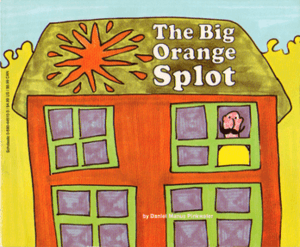The Big Orange Splot facts for kids
 |
|
| Author | Daniel Manus Pinkwater |
|---|---|
| Illustrator | Daniel Manus Pinkwater |
| Publisher | Scholastic, Inc. |
|
Publication date
|
1977 |
| Pages | 32 |
| ISBN | 0-590-44510-3 |
The Big Orange Splot is a fun and colorful children's picture book. It was written by Daniel Manus Pinkwater and came out in 1977. The book tells a story about being unique and celebrating differences. Even though it's a picture book, its ideas are great for all ages. It was published by Scholastic Inc. in New York.
The Story of The Big Orange Splot
The main character in the book is Mr. Plumbean. He lives on a "neat street" where all the houses look exactly the same. One day, a seagull flies over his house. The bird accidentally drops a can of bright orange paint. This paint lands right on Mr. Plumbean's roof, leaving a big orange splot.
Instead of painting his house back to normal, Mr. Plumbean gets a new idea. He decides to paint his house to show his dreams. His house becomes colorful and unique, looking nothing like the others. His neighbors are not happy about this at first. They want their "neat street" to stay the same.
One neighbor goes to talk to Mr. Plumbean. He tries to convince him to repaint his house. But during their chat, this neighbor also gets inspired. He decides to make his own house special too. Gradually, other neighbors visit Mr. Plumbean. They also get ideas for their own homes. Soon, the whole street changes. It is no longer "neat" or boring.
At the end of the story, people from outside the neighborhood might criticize the street. They might say it looks messy or uneven. But the neighbors all have the same answer. They say, "Our street is us and we are it. Our street is where we like to be, and it looks like all our dreams." The pictures in the book were drawn using markers. If you look closely, you can see the lines from the markers.
Why This Book is Used in Schools
This book is used in many elementary schools. Teachers in the US and Canada use it to teach important lessons. It helps students learn about being unique. It also teaches them to accept others' differences. The story encourages creativity and self-expression.

